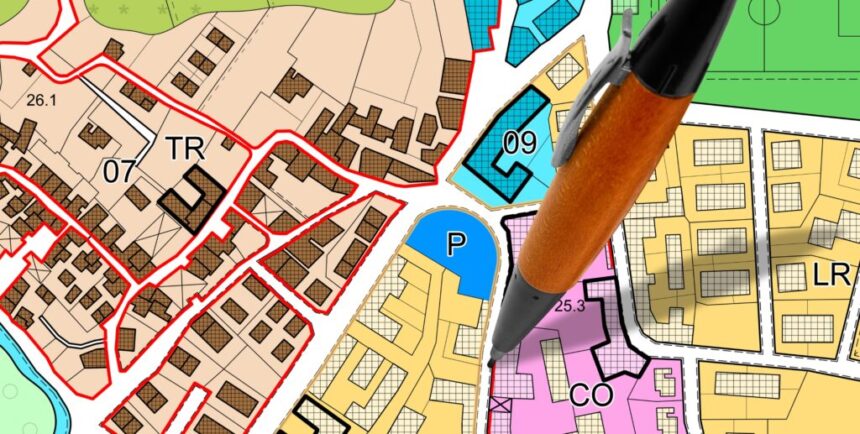Embarking on a ground-up development project may seem like a monumental task, but the opportunity to build something entirely new makes it one of the most exhilarating ventures in real estate. But, at the heart of any successful development analysis lies a thorough understanding of zoning.
This guide will dissect the key facets, from general zoning classifications to intricate parameters such as height restrictions, setbacks, unit density, and the critical interplay of community incentives and neighborhood ordinances.
General Zoning: Decoding Designations
Zoning designations are slightly different in each city, but they share some common ground. In the code, like R3, the R means residential use—usually no offices or retail. The number 3 signals more density and height are allowed compared to, say, R2. Similarly, C means it’s for commercial, and M is for manufacturing.
These simple designations help us understand the basic rules of land use in any city.
Zoning Parameters
Here’s a look at some specific zoning parameters.
Height restrictions and FAR
In most cities, there are designated areas for single-family homes (SFH), typically zoned as R1 or R2, where only single- or two-story structures are permitted. Multifamily buildings and taller structures are usually allowed in areas zoned as R3 or higher. For instance, in densely populated cities like New York, residential zones can go up to R10.
Some zoning allows for unlimited stories, but in these cases, your building’s height is constrained by the floor area ratio (FAR). FAR sets the limit on the total gross building area permitted. For example, if the zoning permits a 10,000-square-foot (sf) building based on the FAR and each floor covers about 2,000 sf, you’re restricted to constructing around five stories without surpassing the FAR limit.
Setbacks
Zoning regulations use building setbacks—side, front, and rear distances—to shape urban structures. By defining these setbacks, zoning codes balance land use efficiency with preserving the surrounding environment’s character.
Side setbacks maintain space between buildings, preventing congestion. Front setbacks enhance streetscapes, creating visual buffers and allowing space for trees and bike parking. Rear setbacks ensure privacy and outdoor space separation.
Some urbanized cities in San Francisco and New York have no building setbacks, and you can build directly against the neighbor’s property. On the other hand, Los Angeles requires at least 5 feet on the sides and 10 feet in the front and rear.
Unit Density
Unit density dictates the maximum number of residential units allowed in a given area. This restriction is a crucial aspect of urban planning, influencing the overall population density and character of a neighborhood. By setting specific limits on unit density, zoning aims to balance the need for housing with considerations such as infrastructure capacity, traffic flow, and the preservation of community aesthetics. These restrictions play a vital role in shaping the social and physical fabric of a locality, ensuring sustainable, harmonious development.
Figure A. Part of the Los Angeles zoning summary
Incentivizing Urban Development Through Affordable Housing
In transit-oriented neighborhoods, capitalizing on affordable housing initiatives strategically amplifies unit density, building height, FAR, and other zoning parameters, thereby expanding the scope of your project. If your development lies within a half-mile radius of a metro station, it’s probable that established policies facilitate augmenting zoning parameters by allocating a specific percentage of units to affordable housing.
For instance, dedicating 10% of your units to low-income housing may translate to a 40% increase in unit counts and a 50% rise in FAR, effectively allowing your project to grow by up to 50%. Even in the absence of preexisting policies, proactive engagement with the city could result in negotiations for incentives.
While not a by-right entitlement, such negotiations are often successful due to the general municipal inclination toward fostering affordable housing. Moreover, state-level incentives may also be accessible to bolster your project’s viability.
Neighborhood Ordinances: Harmonizing Community Values and Development Objectives
In each neighborhood, the presence or absence of a neighborhood ordinance plays a pivotal role, serving as the regulatory backbone for urban development. Understand how these ordinances strike a balance between community interests and the imperative for progress, ensuring the evolution of neighborhoods aligns with their distinct character.
Locating these ordinances isn’t always straightforward. While some are conveniently accessible online, from sources like the zoning map or the city’s website, others necessitate direct contact with the city’s planning staff.
The content of these ordinances varies widely; some may span just a few pages, delineating specifics like building height limitations or transitional requirements from single-family home lots. In contrast, others may extend up to a hundred pages, imposing detailed criteria encompassing design colors, historical features, shapes, and materials.
Remember: The lengthier the ordinance, the more time-consuming the approval process, necessitating careful consideration.
By-Right vs. Discretionary Review
In general, adhering to specified zoning parameters categorizes your project as by-right, alleviating the need for discretionary reviews and neighborhood hearings by the planning department. However, exceptions exist, and legal challenges may arise, stemming from concerns like environmental, traffic, or historical impacts.
Interestingly, even if your project aligns with zoning parameters, larger developments may necessitate discretionary reviews imposed by the city. Notably, certain cities uniformly mandate discretionary reviews, even for a single-family home, a practice more prevalent in smaller cities.
Meanwhile, discretionary review allows local authorities to scrutinize projects more closely. This in-depth examination considers various factors, including community input, aesthetics, and potential impacts on the neighborhood. While this process ensures a tailored approach to each project, it also introduces complexity, as decisions may involve negotiations and public hearings. Discretionary review serves as a mechanism for municipalities to balance the need for development with the preservation of community interests and character.
Final Thoughts
While this article doesn’t encompass the entirety of the intricate, ever-evolving subject of zoning, we’ll discuss that in a coming article. In the meantime, I encourage you to share your questions or additional insights in the comments section.
Ready to succeed in real estate investing? Create a free BiggerPockets account to learn about investment strategies; ask questions and get answers from our community of +2 million members; connect with investor-friendly agents; and so much more.
Note By BiggerPockets: These are opinions written by the author and do not necessarily represent the opinions of BiggerPockets.









